Comparison of Wildfire Meteorology and Climate at the Adriatic Coast and Southeast Australia
Abstract
:1. Introduction
2. Global Context of Fire and Megafire
2.1. Catastrophic Wildfires
2.2. Megafires
2.3. Fire Weather and Fire Regime
3. Fire Weather in the Mediterranean Basin—Adriatic Coast and Croatia
3.1. Syntopic Patterns Conducive to Wildfire
3.2. European Wildfire Studies
3.3. Croatian Wildfire Studies—Wind-Driven
3.4. Croatian Wildfire Studies—Heat-Driven
4. Fire Weather in Southeast Australia
4.1. Synoptic Drivers
4.2. Surface Drying
5. Wildfire and Fire Regimes under Climate Change
5.1. Fire Indices
5.2. Future Fire Regimes
6. Conclusions
6.1. Discussion
6.2. Concluding Remarks
Author Contributions
Funding
Informed Consent Statement
Data Availability Statement
Acknowledgments
Conflicts of Interest
References
- McAneney, J.; Sandercock, B.; Crompton, R.; Mortlock, T.; Musulin, R.; Pielke, R.; Gissing, A. Normalised insurance losses from Australian natural disasters: 1966–2017. Environ. Hazards 2019, 18, 414–433. [Google Scholar] [CrossRef] [Green Version]
- Zscheischler, J.; Westra, S.; Van Den Hurk, B.J.J.M.; Seneviratne, S.I.; Ward, P.J.; Pitman, A.; Aghakouchak, A.; Bresch, D.N.; Leonard, M.; Wahl, T.; et al. Future climate risk from compound events. Nat. Clim. Change 2018, 8, 469–477. [Google Scholar] [CrossRef]
- Di Virgilio, G.; Evans, J.P.; Blake, S.A.P.; Armstrong, M.; Dowdy, A.J.; Sharples, J.; McRae, R. Climate change increases the potential for extreme wildfires. Geophys. Res. Lett. 2019, 46, 8517–8526. [Google Scholar] [CrossRef]
- Ruffault, J.; Curt, T.; Moron, V.; Trigo, R.M.; Mouillot, F.; Koutsias, N.; Pimont, F.; Martin-St Paul, N.; Barbero, R.; Dupuy, J.L.; et al. Increased likelihood of heat-induced large wildfires in the Mediterranean basin. Sci. Rep. 2020, 10, 13790. [Google Scholar] [CrossRef]
- Brey, S.J.; Barnes, E.A.; Pierce, J.R.; Swann, A.L.S.; Fischer, E.V. Past variance and future projections of the environmental conditions driving western U.S. summertime wildfire burn area. Earths Future 2021, 9. [Google Scholar] [CrossRef]
- Vitolo, C.; Di Giuseppe, F.; Barnard, C.; Coughlan, R.; San-Miguel-Ayanz, J.; Libertá, G.; Krzeminski, B. ERA5-based global meteorological wildfire danger maps. Sci. Rep. 2020, 7, 216. [Google Scholar] [CrossRef]
- Chen, B.; Jin, Y.; Scaduto, E.; Moritz, M.A.; Goulden, M.L.; Randerson, J.T. Climate, fuel, and land use shaped the spatial pattern of wildfire in California’s Sierra Nevada. J. Geophys. Res. Biogeosci. 2021, 126. [Google Scholar] [CrossRef]
- Abatzoglou, J.T.; Hatchett, B.J.; Fox-Hughes, P.; Gershunov, A.; Nauslar, N.J. Global climatology of synoptically-forced downslope winds. Int. J. Climatol. 2020, 41, 1–20. [Google Scholar] [CrossRef]
- Potter, B.E. Atmospheric interactions with wildland fire behaviour—I. Basic surface interactions, vertical profiles and synoptic structures. Int. J. Wildland Fire 2012, 21, 779–801. [Google Scholar] [CrossRef]
- VBRC (Victorian Bushfire Royal Commission). The Fires and the Fire-Related Deaths; Final report; Victoria Government: Melbourne, Australia, 2009; Volume 1.
- Lagouvardos, K.; Kotroni, V.; Giannaros, T.M.; Dafis, S. Meteorological conditions conducive to the rapid spread of the deadly wildfire in Eastern Attica, Greece. Bull. Am. Meteorol. Soc. 2019, 100, 2137–2145. [Google Scholar] [CrossRef]
- Brown, T.; Leach, S.; Wachter, B.; Gardunio, B. The northern California 2018 extreme fire season. In ‘Explaining extremes of 2018 from a climate perspective’. Bull. Am. Meteorol. Soc. 2020, 101, S1–S4. [Google Scholar] [CrossRef] [Green Version]
- Mass, C.F.; Ovens, D. The synoptic and mesoscale evolution accompanying the 2018 camp fire of Northern California. Bull. Am. Meteorol. Soc. 2021, 102, E168–E192. [Google Scholar] [CrossRef]
- Wllis, S.; Kanowski, P.; Whelan, R. National Inquiry on Bushfire Mitigation and Management; Council of Australian Government (COAG): Canberra, Australia, 2004.
- Cheney, N.P. Bushfire Disasters in Australia, 1945–1975. Aust. For. 1976, 39, 245–268. [Google Scholar] [CrossRef]
- Borchers Arriagada, N.; Palmer, A.J.; Bowman, D.; Morgan, G.G.; Jalaludin, B.B.; Johnston, F.H. Unprecedented smoke-related health burden associated with the 2019–2020 bushfires in eastern Australia. Med. J. Aust. 2020, 213, 282–283. [Google Scholar] [CrossRef] [PubMed]
- Burgess, T.; Burgmann, J.R.; Hall, S.; Holmes, D.; Turner, E. Black Summer: Australian Newspaper Reporting on the Nation’s Worst Bushfire Season; Monash Climate Change Communication Research Hub; Monash University: Melbourne, Australia, 2020; 30p. [Google Scholar]
- Tariq, A.; Shu, H.; Li, Q.; Altan, O.; Riaz Khan, M.; Fahad Baqa, M.; Lu, L. Quantitative analysis of forecast fires in Southeastern Australia using SAR data. Remote Sens. 2021, 13, 2386. [Google Scholar] [CrossRef]
- McCaw, W.L. Managing forest fuels using prescribed fire—A perspective from southern Australia. For. Ecol. Manag. 2013, 294, 217–224. [Google Scholar] [CrossRef]
- You, C.; Yao, T.; Xu, C. Recent increases in wildfires in the Himalayas and surrounding regions detected in central Tibetan ice core records. J. Geophys. Res. Atmos. 2018, 123, 3285–3291. [Google Scholar] [CrossRef]
- Barlow, J.; Berenguer, E.; Carmenta, R.; França, F. Clarifying Amazonia’s burning crisis. Glob. Change Biol. 2019, 26, 319–321. [Google Scholar] [CrossRef] [Green Version]
- Bento-Gançalves, A.; Vieira, A. Wildfires in the wildland-urban interface: Key concepts and evaluation methodologies. Sci. Total Environ. 2019, 707, 135592. [Google Scholar] [CrossRef]
- Williams, J. Exploring the onset of high-impact mega-fires through a forest land management prism. For. Ecol. Manag. 2013, 294, 4–10. [Google Scholar] [CrossRef]
- San-Miguel-Ayanz, J.; Moreno, J.M.; Camia, A. Analysis of large fires in European Mediterranean landscapes: Lessons learned and perspectives. For. Ecol. Manag. 2013, 294, 11–22. [Google Scholar] [CrossRef]
- Dimitrakopoulos, A.; Gogi, C.; Stamatelos, G.; Mitsopoulos, I. Statistical analysis of the fire environment of large forest fires (>1000 ha) in Greece. Pol. J. Environ. Stud. 2011, 20, 327–332. [Google Scholar]
- Coen, J.L.; Stavros, E.N.; Fites-Kaufman, J.A. Deconstructing the King megafire. Ecol. Appl. 2018, 28, 1565–1580. [Google Scholar] [CrossRef] [PubMed]
- De la Barrera, F.; Barraza, F.; Favier, P.; Ruiz, V.; Quense, J. Megafires in Chile 2017: Monitoring multiscale environmental impacts of burned ecosystems. Sci. Total Environ. 2018, 637–638, 1526–1536. [Google Scholar] [CrossRef] [PubMed]
- Stephens, S.L.; Burrows, N.; Buyantuyev, A.; Gray, R.W.; Keane, R.E.; Kubian, R.; Liu, S.; Seijo, F.; Shu, L.; Tolhurst, K.G.; et al. Temperate and boreal forest mega-fires: Characteristics and challenges. Front. Ecol. Environ. 2014, 12, 115–122. [Google Scholar] [CrossRef] [Green Version]
- Strauss, D.; Bednar, L.; Mees, R. Do one percent of forest fires cause ninety-nine percent of the damage? For. Sci. 1989, 35, 319–328. [Google Scholar]
- Bartlett, T.; Leonard, M.; Morgan, G. The megafire phenomenon: Some Australian perspectives. In The 2007 Institute of Foresters of Australia and New Zealand Institute of Forestry Conference: Programme, Abstracts and Papers; Institute of Foresters of Australia: Canberra, Australia, 2007. [Google Scholar]
- Buckland, M.K. What is a Megafire? Defining the Social and Physical Dimensions of Extreme U.S. Wildfires (1988–2014). Master’s Thesis, Department of Geography, Faculty of the Graduate School, University of Colorado, Boulder, CO, USA, 2019. [Google Scholar]
- Vines, R.G. Physics and chemistry of rural fires. In Fire and the Australian Biota; Gill, A.M., Groves, R.H., Noble, I.R., Eds.; Australian Academy of Sciences: Canberra, Australia, 1981; pp. 129–149. [Google Scholar]
- Sharples, J.J.; Cary, G.J.; Fox-Hughes, P.; Mooney, S.; Evans, J.P.; Fletcher, M.S.; Fromm, M.; Grierson, P.F.; McRae, R.; Baker, P. Natural hazards in Australia: Extreme bushfire. Clim. Change 2016, 139, 85–99. [Google Scholar] [CrossRef]
- Potter, B.E. Atmospheric interactions with wildland fire behaviour—II. Plume and vortex dynamics. Int. J. Wildland Fire 2012, 21, 802–817. [Google Scholar] [CrossRef]
- Dowdy, A.J.; Fromm, M.D.; McCarthy, N. Pyrocumulonimbus lightning and fire ignition on Black Saturday in southeast Australia. J. Geophys. Res. Atmos. 2017, 122, 7342–7354. [Google Scholar] [CrossRef]
- McRae, R.; Sharples, J.J.; Wilkes, S.R.; Walker, A. An Australian pyro-tornadogenesis event. Nat. Hazards 2013, 65, 1801–1811. [Google Scholar] [CrossRef]
- Laureau, N.P.; Nauslar, N.J.; Abatzoglou, J.T. The Carr fire vortex: A case of pyrotornadogenesis? Geophys. Res. Lett. 2019, 45, 107–113. [Google Scholar] [CrossRef]
- Peace, M.; Hanstrum, B.; Greenslade, J.; Zovko-Rajak, D.; Santra, A.; Kepert, J.; Fox-Hughes, P.; Ye, H.; Shermin, T.; Jones, J. Coupled Fire-Atmosphere Simulations of Five Black Summer Fires Using the ACCESS-Fire Model—Black Summer Final Report; Bushfire and Natural Hazards CRC: Melbourne, Australia, 2021. [Google Scholar]
- Cunningham, P.; Reeder, M.J. Severe convective storms initiated by intense wildfires: Numerical simulations of pyro-convection and pyro-tornadogenesis. Geophys. Res. Lett. 2009, 36, L12812. [Google Scholar] [CrossRef]
- Fromm, M.; Tupper, A.; Rosenfeld, D.; Servranck, R.; McRae, R. Violent pyro-convective storm devastates Australia’s capital and pollutes the stratosphere. Geophys. Res. Lett. 2006, 33, L05815. [Google Scholar] [CrossRef]
- Cruz, M.G.; Sullivan, A.L.; Gould, J.S.; Sims, N.C.; Bannister, A.J.; Hollis, J.J.; Hurley, R.J. Anatomy of a catastrophic wildfire: The Black Saturday Kilmore East fire in Victoria, Australia. For. Ecol. Manag. 2012, 284, 269–285. [Google Scholar] [CrossRef]
- Field, R.D.; Luo, M.; Fromm, M.; Voulgarakis, A.; Mangeon, S.; Worden, J. Simulating the Black Saturday 2009 smoke plume with an interactive composition-climate model: Sensitivity to emissions amount, timing, and injection height. J. Geophys. Res. Atmos. 2016, 121, 4296–4316. [Google Scholar] [CrossRef] [PubMed] [Green Version]
- Ndalila, M.N.; Williamson, G.J.; Fox-Hughes, P.; Sharples, J.; Bowman, D.M.J.S. Evolution of an extreme pyrocumulonimbus-driven wildfire event in Tasmania, Australia. Nat. Hazards Earth Syst. Sci. 2019, 20, 1497–1511. [Google Scholar] [CrossRef]
- Peterson, D.A.; Campbell, J.R.; Hyer, E.J.; Fromm, M.D.; Kablick, P., III; Cossuth, J.H.; Deland, M.T. Wildfire-driven thunderstorms cause a volcano-like stratospheric injection of smoke. Npj Clim. Atmos. Sci. 2018, 1, 30. [Google Scholar] [CrossRef] [Green Version]
- Peterson, D.A.; Fromm, M.D.; McRae, R.H.; Campbell, J.R.; Hyer, E.J.; Taha, G.; Camacho, C.P.; Kablick, G.P.; Schmidt, C.C.; DeLand, M.T. Australia’s Black Summer pyrocumulonimbus super outbreak reveals potential for increasingly extreme stratospheric smoke events. Npj Clim. Atmos. Sci. 2021, 4, 1–16. [Google Scholar] [CrossRef]
- Mifka, B.; Vučetić, V. Weather analysis during extreme forest fire on island of Brač from 14 to 17 July 2011. Firef. Manag. 2012, 1, 13–25. (In Croatian) [Google Scholar]
- Werth, P.A.; Potter, B.E.; Clements, C.B.; Finney, M.A.; Forthofer, J.A.; McAllister, S.S.; Goodrick, S.L.; Alexander, M.E.; Cruz, M.G. Synthesis of Knowledge of Extreme Fire Behavior: Volume I for Fire Managers, JFSP Synthesis Reports; Department of Agriculture, Forest Service: Portland, OR, USA, 2011.
- Werth, P.A. Critical fire weather patterns. Fire Manag. Today 2017, 1, 28–32. [Google Scholar]
- Luke, R.; McArthur, A. Bushfires in Australia; Australian Government Publishing Service: Canberra, Australia, 1978. [Google Scholar]
- Potter, B.E. Atmospheric Properties Associated with Large Wildfires. Int. J. Wildland Fire 1996, 6, 71–76. [Google Scholar] [CrossRef]
- Lucas, C. On developing a historical fire weather data-set for Australia. Aust. Meteorol. Oceanogr. J. 2010, 60, 1–14. [Google Scholar] [CrossRef] [Green Version]
- Flannigan, M.D.; Krawchuk, M.A.; de Groot, W.J.; Wotton, B.M.; Gowman, L.M. Implications of changing climate for global wildland fire. Int. J. Wildland Fire 2009, 18, 483–507. [Google Scholar] [CrossRef]
- Flannigan, M.D.; Stocks, B.J.; Wotton, B.M. Climate change and forest fires. Sci. Total Environ. 2000, 262, 221–229. [Google Scholar] [PubMed]
- Flannigan, M.D.; Harrington, J.B. A study of the relation of meteorological variables to monthly provincial area burned by wildfire in Canada 1953–80. J. Appl. Meteorol. 1988, 27, 441–452. [Google Scholar] [CrossRef]
- Johnson, E.A.; Wowchuk, D.R. Wildfires in the southern Canadian Rocky Mountains and their relationship to mid-tropospheric anomalies. Can. J. For. Res. 1993, 23, 1213–1222. [Google Scholar] [CrossRef]
- Swetnam, T.W. Fire history and climate change in giant sequoia groves. Science 1993, 262, 885–889. [Google Scholar] [CrossRef]
- Flannigan, M.D.; Logan, K.A.; Amiro, B.D.; Skinner, W.R.; Stocks, B.J. Future Area Burned in Canada. Clim. Change 2005, 72, 1–16. [Google Scholar] [CrossRef]
- Turco, M.; Von Hardenberg, J.; AghaKouchak, A.; Llasat, M.C.; Provenzale, A.; Trigo, R.M. On the key role of droughts in the dynamics of summer fires in Mediterranean Europe. Sci. Rep. 2017, 7, 81. [Google Scholar] [CrossRef] [Green Version]
- Millán, M.M.; Estrela, M.J.; Badenas, C. Meteorological processes relevant to forest fire dynamics on the Spanish Mediterranean coast. J. Appl. Meteorol. 1998, 37, 83–100. [Google Scholar] [CrossRef]
- Lionello, P.; Malanotte-Rizzoli, P.; Boscolo, R.; Alpert, P.; Artale, V.; Li, L.; Luterbacher, J.; May, W.; Trigo, R.M.; Tsimplis, M.; et al. The Mediterranean climate: An overview of the main characteristics and issues. In Mediterranean, Developments in Earth and Environmental Sciences; Lionello, P., Malanotte-Rizzoli, P., Boscolo, R., Eds.; Elsevier: Amsterdam, The Netherlands, 2006; pp. 1–26. [Google Scholar] [CrossRef]
- Scorer, R.S. Mountain-gap winds: A study of surface winds at Gibraltar. Q. J. R. Meteorol. Soc. 1952, 78, 53–61. [Google Scholar] [CrossRef]
- Hoinka, K.P.; de Castro, M. The Iberian Peninsula thermal low. Q. J. R. Meteorol. Soc. 2003, 129, 1491–1511. [Google Scholar] [CrossRef] [Green Version]
- Jézéquel, A.; Cattiaux, J.; Naveau, P.; Radanovics, S.; Ribes, A.; Vautard, R.; Vrac, M.; Yiou, P. Trends of atmospheric circulation during singular hot days in Europe. Environ. Res. Lett. 2018, 13, 54007. [Google Scholar] [CrossRef]
- Sousa, P.M.; Trigo, R.M.; Barriopedro, D.; Soares, P.M.M.; Santos, J.A. European temperature responses to blocking and ridge regional patterns. Clim. Dyn. 2018, 50, 457–477. [Google Scholar] [CrossRef]
- Fink, A.H.; Brücher, T.; Krüger, A.; Leckebusch, G.C.; Pinto, J.G.; Ulbrich, U. The 2003 European summer heatwaves and drought—Synoptic diagnosis and impacts. Weather 2004, 59, 209–216. [Google Scholar] [CrossRef] [Green Version]
- Pereira, M.G.; Trigo, R.M.; Da Camara, C.C.; Pereira, J.M.C.; Leite, S.M. Synoptic patterns associated with large summer forest fires in Portugal. Agric. For. Meteorol. 2005, 129, 11–25. [Google Scholar] [CrossRef]
- Trigo, R.M.; Pereira, J.M.C.; Pereira, M.G.; Mota, B.; Calado, T.J.; Dacamara, C.C.; Santo, F.E. Atmospheric conditions associated with the exceptional fire season of 2003 in Portugal. Int. J. Climatol. 2006, 26, 1741–1757. [Google Scholar] [CrossRef]
- Amraoui, M.; Liberato, M.L.R.; Calado, T.J.; DaCamara, C.C.; Coelho, L.P.; Trigo, R.M.; Gouveia, C.M. Fire activity over Mediterranean Europe based on information from Meteosat-8. For. Ecol. Manag. 2013, 294, 62–75. [Google Scholar] [CrossRef]
- Rasilla, D.F.; García-Codron, J.C.; Carracedo, V.; Diego, C. Circulation patterns, wildfire risk and wildfire occurrence at continental Spain. Phys. Chem. Earth 2010, 35, 553–560. [Google Scholar] [CrossRef]
- Cardil, A.; Eastaugh, C.S.; Molina, D.M. Extreme temperature conditions and wildland fires in Spain. Theor. Appl. Climatol. 2015, 122, 219–228. [Google Scholar] [CrossRef]
- Trigo, R.M.; Sousa, P.M.; Pereira, M.G.; Rasilla, D.; Gouveia, C.M. Modelling wildfire activity in Iberia with different atmospheric circulation weather types. Int. J. Climatol. 2016, 36, 2761–2778. [Google Scholar] [CrossRef]
- Cardil, A.; Salis, M.; Spano, D.; Delogu, G.; Molina, T.D. Large wildland fires and extreme temperatures in Sardinia (Italy). iForest 2014, 7, 161–168. [Google Scholar] [CrossRef] [Green Version]
- Kassomenos, P. Synoptic circulation control on wild fire occurrence. Phys. Chem. Earth 2010, 35, 544–552. [Google Scholar] [CrossRef]
- Papadopoulos, A.; Paschalidou, A.K.; Kassomenos, P.A.; McGregor, G. Investigating the relationship of meteorological/climatological conditions and wildfires in Greece. Theor. Appl. Climatol. 2013, 112, 113–126. [Google Scholar] [CrossRef]
- Levin, N.; Saaroni, H. Fire weather in Israel—Synoptic climatological analysis. GeoJournal 1999, 47, 523–538. [Google Scholar] [CrossRef]
- Newark, M.J. The relationship between forest fire occurrence and 500-mb longwave ridging. Atmosphere 1975, 13, 26–33. [Google Scholar] [CrossRef] [Green Version]
- Skinner, W.R.; Stocks, B.J.; Martell, D.L.; Bonsal, B.; Shabbar, A. The association between circulation anomalies in the mid-troposphere and area burned by wildland fire in Canada. Theor. Appl. Climatol. 1999, 63, 89–105. [Google Scholar] [CrossRef]
- Nimchuk, N. Wildfire Behavior Associated with Upper Ridge Breakdown, Report Number T/50; Alberta Energy and Natural Resources Forest Service: Edmonton, AB, Canada, 1983. [Google Scholar]
- Efimov, V.V.; Stanichnyi, S.V.; Shokurov, M.V.; Yarovaya, D.A. Observations of a quasi-tropical cyclone over the Black Sea. Russ. Meteorol. Hydrol. 2008, 33, 233239. [Google Scholar] [CrossRef]
- Kartsios, S.; Karacostas, T.; Pytharoulis, I.; Dimitrakopoulos, A.P. Numerical investigation of atmosphere-fire interactions during high-impact wildland fire events in Greece. Atmos. Res. 2021, 247, 105253. [Google Scholar] [CrossRef]
- Barešić, D. The Impact of Climate Change on the Potential Risk of Forest Fires in Croatia. Master’s Thesis, Faculty of Science, University of Zagreb, Zagreb, Croatia, 2011. (In Croatian). [Google Scholar]
- DUSZ (National Protection and Rescue Directorate). Report on the Realization of the Program of Activities in the Implementation of Special Measures of Protection from Forest Fires in Republic of Croatia in 2017; National Protection and Rescue Directorate: Zagreb, Croatia, 2018. (In Croatian) [Google Scholar]
- Tomašević, I.Č.; Cheung, K.K.W.; Vučetić, V.; Fox-Hughes, P.; Horvath, K.; Prtenjak, M.T.; Beggs, P.J.; Malečić, B.; Milić, V. The 2017 Split wildfire in Croatia: Evolution and the role of meteorological conditions. Nat. Hazards Earth Syst. Sci. 2022; submitted. [Google Scholar]
- Vučetić, M. Meteorological conditions of a catastrophic forest fire on Korčula in 1985. Croat. Meteorol. J. (Rasprave) 1987, 22, 67–72. (In Croatian) [Google Scholar]
- Vučetić, M. Weather phenomena during the 13–31 July 1990 forest fire on the island of Hvar. Croat. Meteorol. J. 1992, 27, 69–76. (In Croatian) [Google Scholar]
- Vučetić, M. The influence of weather condition on forest fire on the island of Hvar, 28 July–4 August 1997. In Proceedings of the International Conference on Forest Fire Research and 14th Conference on Fire and Forest Meteorology, Luso, Portugal, 16–20 November 1998; pp. 1295–1303. [Google Scholar]
- Vučetić, M.; Vučetić, V. Different types of the forest fires on the Croatian coast. In Forest Fires: Needs & Innovations; Organised by CINAR: Athens, Greece, 1999; pp. 365–369. [Google Scholar]
- Byram, G.M. Atmospheric Conditions Related to Blowup Fires, Station Paper SE-SP-35, USDA-Forest Service; Southeastern Forest Experiment Station: Asheville, NC, USA, 1954. [Google Scholar]
- Vučetić, V.; Ivatek Šahdan, S.; Tudor, M.; Kraljević, L.; Ivančan-Picek, B.; Strelec-Mahović, N. Weather analysis during the Kornat fire on 30 August 2007. Croat. Meteorol. J. 2007, 42, 41–65. (In Croatian) [Google Scholar]
- Vučetić, M.; Vučetić, V. Fire risk analysis during the Kornat fire on 30 August 2007. Firef. Manag. 2011, 1, 12–25. (In Croatian) [Google Scholar]
- Tomašević, I. Vertical Atmospheric Profiles during the Large Wild-Land Fires. Master’s Thesis, Faculty of Science, University of Zagreb, Zagreb, Croatia, 2012. (In Croatian). [Google Scholar]
- Vučetić, V.; Čavlina Tomašević, I.; Mifka, B. Low level jet and large wildfires in Croatia. In Proceedings of the 6th International Fire Behavior and Fuels Conference, Marseille, France, 29 April–3 May 2019. [Google Scholar]
- Kozarić, T.; Mokorić, M. Kvarner fire 23rd and 24th July 2012—Weather analysis. Firef. Manag. 2012, 2, 53–66. (In Croatian) [Google Scholar]
- Mills, G.H. A re-examination of the synoptic and mesoscale meteorology of Ash Wednesday 1983. Aust. Met. Mag. 2005, 54, 35–55. [Google Scholar]
- Omazić, B.; Vučetić, V. Weather condition analysis during wildfires on the Pelješac Peninsula in July 2015. Firef. Manag. 2017, 7, 6–23. (In Croatian) [Google Scholar]
- Westerling, A.L.; Cayan, D.R.; Brown, T.J.; Hall, B.L.; Riddle, L.G. Climate, Santa Ana winds and autumn wildfires in southern California. Eos Trans. AGU 2004, 85, 289–296. [Google Scholar] [CrossRef]
- Kuraži, D.; Vučetić, V. Weather analysis of a large forest fire on Mount Strahinjčica in March 2012. Firef. Manag. 2015, 5, 5–16. (In Croatian) [Google Scholar]
- Foley, J.C. A Study of Meteorological Conditions Associated with Bush and Grass Fires and Fire Protection Strategy in Australia, Bulletin Number 38; Bureau of Meteorology: Melbourne, Australia, 1947.
- Reeder, M.J.; Smith, R.K. Australian spring and summer cold fronts. Aust. Meteorol. Mag. 1992, 41, 101–124. [Google Scholar]
- Mills, G.A. A case of coastal interaction with a cool change. Aust. Meteorol. Mag. 2002, 51, 203–211. [Google Scholar]
- Mills, G.A.; Pendlebury, S. Processes leading to a severe windshear incident at Hobart Airport. Aust. Meteorol. Mag. 2003, 52, 171–188. [Google Scholar]
- Reeder, M.J.; Smith, R.K. Mesoscale meteorology. In Meteorology of the Southern Hemisphere; Vincent, D., Karoly, D.J., Eds.; American Meteorological Society: Boston, MA, USA, 1998; pp. 201–241. [Google Scholar]
- Reeder, M.J.; Spengler, T.; Musgrave, R. Rossby waves, extreme fronts, and wildfires in southeastern Australia. Geophys. Res. Lett. 2015, 42, 2015–2023. [Google Scholar] [CrossRef]
- Long, M. A climatology of extreme fire weather days in Victoria. Aust. Met. Mag. 2006, 55, 3–18. [Google Scholar]
- BoM (Bureau of Meteorology). Meteorological Aspects of the 7 February 2009 Victorian Fires, An Overview. Bureau of Meteorology Report for the 2009 Victorian Bushfires Royal Commission; Bureau of Meteorology: Melbourne, Australia, 2009.
- Engel, C.B.; Lane, T.P.; Reeder, M.J.; Rezny, M. The meteorology of Black Saturday. Q. J. R. Meteorol. Soc. 2013, 139, 585–599. [Google Scholar] [CrossRef]
- Bond, H.G.; Mackinnon, K.; Noar, P.F. Report on the Meteorological Aspects of the Catastrophic Bushfires in the South-Eastern Tasmania on 7 February 1967; Bureau of Meteorology: Melbourne, Australia, 1967.
- BoM (Bureau of Meteorology). Tasmanian Bushfires Inquiry; Bureau of Meteorology: Hobart, Australia, 2013.
- Collins, L.; Bradstock, R.A.; Clarke, H.; Clarke, M.F.; Nolan, R.H.; Penman, T.D. The 2019/2020 mega-fires exposed Australian ecosystems to an unprecedented extent of high-severity fire. Environ. Res. Lett. 2021, 16, 044029. [Google Scholar] [CrossRef]
- Hasson, A.E.A.; Mills, G.A.; Timbal, B.; Walsh, K. Assessing the impact of climate change on extreme fire weather events over southeastern Australia. Clim. Res. 2009, 39, 159–172. [Google Scholar] [CrossRef] [Green Version]
- Grose, M.R.; Fox-Hughes, P.; Harris, R.M.B.; Bindoff, N.L. Changes to the drivers of fire weather with a warming climate—A case study of southeast Tasmania. Clim. Change 2014, 124, 255–269. [Google Scholar] [CrossRef]
- Sharples, J.J.; Mills, G.A.; McRae, R.H.D.; Weber, R.O. Foehn-Like winds and elevated fire danger conditions in southeastern Australia. J. Appl. Meteorol. Climatol. 2010, 49, 1067–1095. [Google Scholar] [CrossRef]
- Brinkmann, W.A.R. What is a foehn? Weather 1971, 26, 230–239. [Google Scholar] [CrossRef]
- Whiteman, C.D. Mountain Meteorology: Fundamentals and Applications; Oxford University Press: New York, NY, USA, 2000. [Google Scholar]
- McArthur, A.G. Fire Behaviour in Eucalypt Forests, Leaflet Number 107; Commonwealth of Australia Department of National Development, Forestry and Timber Bureau: Canberra, Australia, 1967.
- Fox-Hughes, P.; Harris, R.M.B.; Lee, G.; Grose, M.R.; Bindoff, N.L. Future fire danger climatology for Tasmania, Australia, using a dynamically downscaled regional climate model. Int. J. Wildland Fire 2014, 23, 309–321. [Google Scholar] [CrossRef]
- Marsh, L. Fire Weather Forecasting in Tasmania, Meteorological Note 171; Bureau of Meteorology: Melbourne, Australia, 1987; 47p.
- Fox-Hughes, P. Springtime fire weather in Tasmania, Australia: Two case studies. Weather Forecast. 2012, 27, 379–395. [Google Scholar] [CrossRef] [Green Version]
- Mills, G.A. Abrupt surface drying and fire weather Part 1: Overview and case study of the South Australian fires of 11 January 2005. Aust. Meteorol. Mag. 2008, 57, 299–309. [Google Scholar]
- Mills, G.A. Abrupt surface drying and fire weather Part 2: A preliminary synoptic climatology in the forested areas of southern Australia. Aust. Meteorol. Mag. 2008, 57, 311–328. [Google Scholar]
- Haines, D.A. A lower atmosphere severity index for wildlife fires. Natl. Weather Dig. 1988, 13, 23–27. [Google Scholar]
- Bally, J. The Haines Index as a predictor of fire activity in Tasmania. In Proceedings of the Bushfire ’95, Australian Bushfire Conference, Hobart, Australia, 27–30 September 1995. [Google Scholar]
- BoM (Bureau of Meteorology). Fire Weather Directive—Tasmania and Antarctic Regional Office; Bureau of Meteorology: Hobart, Australia, 2008; 53p.
- Mills, G.A.; McCaw, L. Atmospheric Stability Environments and Fire Weather in Australia—Extending the Haines Index, CAWCR Technical Report No. 20; Centre for Australian Weather and Climate Research: Melbourne, Australia, 2010.
- Tory, K.J.; Kepert, J.D. Pyrocumulonimbus Firepower Threshold: Assessing the atmospheric potential for pyroCb. Weather Forecast. 2021, 36, 439–456. [Google Scholar] [CrossRef]
- Turco, M.; Rosa-Cánovas, J.J.; Bedia, J.; Jerez, S.; Montávez, J.P.; Llasat, M.C.; Provenzale, A. Exacerbated fires in Mediterranean Europe due to anthropogenic warming projected with nonstationary climate-fire models. Nat. Commun. 2018, 9, 3821. [Google Scholar] [CrossRef]
- IPCC. Climate Change 2021: The Physical Science Basis. In Contribution of Working Group I to the Sixth Assessment Report of the Intergovernmental Panel on Climate Change; Masson-Delmotte, V., Zhai, P., Pirani, A., Connors, S.L., Péan, C., Berger, S., Caud, N., Chen, Y., Goldfarb, L., Gomis, M.I., et al., Eds.; Cambridge University Press: London, UK, 2021. [Google Scholar]
- Nicholls, N. The changing nature of Australian droughts. Clim. Change 2004, 63, 323–336. [Google Scholar] [CrossRef]
- Hennessy, K.; Lucas, C.; Nicholls, N.; Bathols, J.; Suppiah, R.; Ricketts, J. Climate Change Impacts on Fire Weather in Southeast Australia. CSIRO Marine and Atmospheric Research Report; CSIRO Marine and Atmospheric Research: Aspendale, Australia, 2005. [Google Scholar]
- Nolan, R.H.; Boer, M.M.; Collins, L.; Resco de Dios, V.; Clarke, H.G.; Jenkins, M.; Kenny, B.; Bradstock, R.A. Causes and consequences of eastern Australia’s 2019–20 season of mega-fires. Glob. Change Biol. 2020, 26, 1039–1041. [Google Scholar] [CrossRef] [Green Version]
- Abram, N.J.; Henley, B.J.; Gupta, A.S.; Lippmann, T.J.; Clarke, H.; Dowdy, A.J.; Sharples, J.J.; Nolan, R.H.; Zhang, T.; Wooster, M.J.; et al. Connections of climate change and variability to large and extreme forest fires in southeast Australia. Commun. Earth Environ. 2021, 2, 1–17. [Google Scholar] [CrossRef]
- Van Oldenborgh, G.J.; Krikken, F.; Lewis, S.; Leach, N.J.; Lehner, F.; Saunders, K.R.; van Weele, M.; Haustein, K.; Li, S.; Wallom, D.; et al. Attribution of the Australian bushfire risk to anthropogenic climate change. Nat. Hazards Earth Syst. Sci. 2021, 21, 941–960. [Google Scholar] [CrossRef]
- Kelly, L.T.; Giljohann, K.M.; Duane, A.; Aquilué, N.; Archibald, S.; Batllori, E.; Bennett, A.F.; Buckland, S.T.; Canelles, Q.; Clarke, M.F.; et al. Fire and biodiversity in the Anthropocene. Science 2020, 370. [Google Scholar] [CrossRef] [PubMed]
- Dowdy, A.J.; Mills, G.A.; Finkele, K.; de Groot, W. Australian Fire Weather as Represented by the McArthur Forest Fire Danger Index and the Canadian Forest Fire Weather Index. CAWCR Technical Report No. 10; Centre for Australian Weather and Climate Research: Melbourne, Australia, 2009.
- Fox-Hughes, P. Impact of More Frequent Observations on the Understanding of Tasmanian Fire Danger. J. Appl. Meteorol. Climatol. 2011, 50, 1617–1626. [Google Scholar] [CrossRef]
- Clarke, H.G.; Lucas, C.; Smith, P.L. Changes in Australian fire weather between 1973 and 2010. Int. J. Climatol. 2013, 33, 931–944. [Google Scholar] [CrossRef]
- Harris, S.; Mills, G.; Brown, T. Variability and drivers of extreme fire weather in fire-prone areas of south-eastern Australia. Int. J. Wildland Fire 2017, 26, 177–190. [Google Scholar] [CrossRef]
- Enright, N.J.; Fontaine, J.B. Climate Change and the Management of Fire-Prone Vegetation in Southwest and Southeast Australia. Geogr. Res. 2013, 52, 34–44. [Google Scholar] [CrossRef]
- Lucas, C.; Hennessy, K.; Mills, G.; Bathols, J. Bushfire Weather in Southeast Australia: Recent Trends and Projected Climate Change Impacts, Consultancy Report Prepared for The Climate Institute of Australia; Bureau of Meteorology Research Centre: Melbourne, Australia, 2007.
- Dowdy, A.J. Climatological Variability of Fire Weather in Australia. J. Appl. Meteorol. Climatol. 2018, 57, 221–234. [Google Scholar] [CrossRef]
- Dowdy, A.J.; Pepler, A. Pyroconvection risk in Australia: Climatological changes in atmospheric stability and surface fire weather conditions. Geophys. Res. Lett. 2018, 45, 2005–2013. [Google Scholar] [CrossRef]
- Clarke, H.G.; Evans, J.P. Exploring the future change space for fire weather in southeast Australia. Theor. Appl. Climatol. 2019, 136, 513–527. [Google Scholar] [CrossRef] [Green Version]
- Vučetić, M. Weather conditions and forest fires on the coastal area of Croatia during 2000. J. For. 2001, 7–8, 367–378. (In Croatian) [Google Scholar]
- Vučetić, M. Weather conditions and a comparison of the forest fire season 2001 with long-term mean values. J. For. 2002, 11–12, 563–574. (In Croatian) [Google Scholar]
- Bakšić, N.; Vučetić, M.; Španjol, Ž. A potential risk of fire on open space in the Republic of Croatia. Firef. Manag. 2015, 5, 30–40. (In Croatian) [Google Scholar]
- Tomašević, I.; Vučetić, V. Rating the fire season 2013 and comparison with the fire season 2012. Firef. Manag. 2014, 4, 19–35. (In Croatian) [Google Scholar]
- Vučetić, M.; Vučetić, V. Wildfire risk in Croatia using the Canadian Forest Fire Weather Index System. In Proceedings of the 6th International Fire Behavior and Fuels Conference, Marseille, France, 29 April–3 May 2019. [Google Scholar]
- Vučetić, M.; Vučetić, V.; Španjol, Ž.; Barčić, D.; Rosavec, R.; Mandić, A. Secular variations of monthly severity rating on the Croatian Adriatic coast during the forest fire season. For. Ecol. Manag. 2006, 234 (Suppl. 1), 251. [Google Scholar]
- Boegelsack, N.; Withey, J.; O’Sullivan, G.; McMartin, D. A critical examination of the relationship between wildfires and climate change with consideration of the human impact. J. Environ. Prot. Sci. 2018, 9, 461–467. [Google Scholar] [CrossRef] [Green Version]
- Bowman, D.M.J.; Balch, J.K.; Artaxo, P.; Bond, W.J.; Carlson, J.M.; Cochrane, M.A.; D’Antonio, C.M.; DeFries, R.S.; Doyle, J.C.; Harrison, S.P.; et al. Fire in the Earth System. Science 2009, 324, 481–484. [Google Scholar] [CrossRef]
- Moritz, M.A.; Parisien, M.A.; Batllori, E.; Krawchuk, M.A.; Van Dorn, J.; Ganz, D.J.; Hayhoe, K. Climate change and disruptions to global fire activity. Ecosphere 2012, 3, 49. [Google Scholar] [CrossRef]
- Keeley, J.E. Fire in Mediterranean climate ecosystems—A comparative overview. Isr. J. Ecol. Evol. 2012, 58, 123–135. [Google Scholar] [CrossRef]
- Keeley, J.E.; Syphard, A.D. Climate change and future fire regimes: Examples from California. Geosci. J. 2016, 6, 37. [Google Scholar] [CrossRef] [Green Version]
- Flannigan, M.D.; Cantin, A.S.; de Groot, W.J.; Wotton, M.; Newbery, A.; Gowman, L.M. Global wildland fire season severity in the 21st century. For. Ecol. Manag. 2013, 294, 54–61. [Google Scholar] [CrossRef]
- Giorgi, F. Climate change hot-spots. Geophys. Res. Lett. 2006, 33, L08707. [Google Scholar] [CrossRef]
- Rodriguesa, M.; Trigod, R.M.; Vega-Garcíaa, C.; Cardil, A. Identifying large fire weather typologies in the Iberian Peninsula. Agric. For. Meteorol. 2020, 280, 107789. [Google Scholar] [CrossRef]
- Bedia, J.; Herrera, S.; Camia, A.; Moreno, J.M.; Gutiérrez, J.M. Forest fire danger projections in the Mediterranean using ENSEMBLES regional climate change scenarios. Clim. Change 2014, 122, 185–199. [Google Scholar] [CrossRef] [Green Version]
- Turco, M.; Llasat, M.C.; Von Hardenberg, J.; Provenzale, A. Climate change impacts on wildfires in a Mediterranean environment. Clim. Change 2014, 125, 369–380. [Google Scholar] [CrossRef]
- Fargeon, H.; Pimont, F.; Martin-St Paul, N.; de Caceres, M.; Ruffault, J.; Barbero, R.; Dupuy, J.L. Projections of fire danger under climate change over France: Where do the greatest uncertainties lie? Clim. Change 2020, 160, 479–493. [Google Scholar] [CrossRef]
- Dupuy, J.L.; Fargeon, H.; Martin-St Paul, N.; Pimont, F.; Ruffault, J.; Guijarro, M.; Hernando, C.; Madrigal, J.; Fernandes, P. Climate change impact on future wildfire danger and activity in southern Europe: A review. Ann. For. Sci. 2020, 77. [Google Scholar] [CrossRef]
- Camia, A.; Amatulli, G.; San-Miguel-Ayanz, J. Past and Future Trends of Forest Fire Danger in Europe, JRC Scientific and Technical Reports No. 6; European Commission, Joint Research Centre: Ispra, Italy, 2008. [Google Scholar]
- Moriondo, M.; Good, P.; Durao, R.; Bindi, M.; Giannakopoulos, C.; Corte-Real, J. Potential impact of climate change on fire risk in the Mediterranean area. Clim. Res. 2006, 31, 85–95. [Google Scholar] [CrossRef]
- Williams, A.A.J.; Karoly, D.J.; Tapper, N. The sensitivity of Australian fire danger to climate change. Clim. Change 2001, 49, 171–191. [Google Scholar] [CrossRef]
- Cary, G.J. Importance of a changing climate for fire regimes in Australia. In Flammable Australia: The Fire Regimes and Biodiversity of a Continent; Bradstock, R.A., Williams, J.E., Gill, A.M., Eds.; Cambridge University Press: Cambridge, UK, 2002. [Google Scholar]
- Pitman, A.J.; Narisma, G.T.; McAneney, J. The impact of climate change on the risk of forest and grassland fires in Australia. Clim. Change 2007, 84, 383–401. [Google Scholar] [CrossRef]
- Bradstock, R.A.; Cohn, J.S.; Gill, A.M.; Bedward, M.; Lucas, C. Prediction of the probability of large fires in the Sydney region of south-eastern Australia using fire weather. Int. J. Wildland Fire 2009, 18, 932–943. [Google Scholar] [CrossRef]
- Clarke, H.G.; Smith, P.L.; Pitman, A.J. Regional signatures of future fire weather over eastern Australia from global climate models. Int. J. Wildland Fire 2011, 20, 550–562. [Google Scholar] [CrossRef]
- Teague, B.; McLeod, R.; Pascoe, S. 2009 Final Report Summary, Victorian Bushfires Royal Commission; Parliament of Victoria: Melbourne, Australia, 2010.
- Di Virgillo, G.; Evans, J.P.; Clarke, H.; Sharples, J.; Hirsch, A.L.; Hart, M.A. Climate Change Significantly Alters Future Wildfire Mitigation Opportunities in Southeastern Australia. Geophys. Res. Lett. 2020, 47. [Google Scholar] [CrossRef]
- Krawchuk, M.A.; Moritz, M.A.; Parisien, M.-A.; Van Dorn, J.; Hayhoe, K. Global Pyrogeography: The Current and Future Distribution of Wildfire. PLoS ONE 2009, 4, e5102. [Google Scholar] [CrossRef] [PubMed]
- Keegan, K.M.; Albert, M.R.; McConnell, J.R.; Baker, I. Climate change and forest fires synergistically drive widespread melt events of the Greenland Ice Sheet. Proc. Nat. Acad. Sci. USA 2014, 111, 7964–7967. [Google Scholar] [CrossRef] [PubMed] [Green Version]
- Andela, N.; Morton, D.C.; Giglio, L.; Chen, Y.; van der Werf, G.F.; Kasibhatla, P.S.; DeFries, R.S.; Collatz, R.J.; Hantson, S.; Kloster, S.; et al. A human-driven decline in global burned area. Science 2017, 356, 1356–1362. [Google Scholar] [CrossRef] [Green Version]
- Grisogono, B.; Belušić, D. A review of recent advances in understanding the meso- and micro-scale properties of the severe Bora wind. Tellus A Dyn. Meteorol. Oceanogr. 2009, 61, 1–16. [Google Scholar] [CrossRef]
- Romanić, D. Local winds of Balkan Peninsula. Int. J. Climatol. 2019, 39, 117. [Google Scholar] [CrossRef] [Green Version]
- Juliano, T.W.; Parish, T.R.; Rahn, D.A.; Leon, D.C. An atmospheric hydraulic jump in the Santa Barbara Channel. J. Appl. Meteorol. Climatol. 2017, 56, 29812998. [Google Scholar] [CrossRef]
- Huang, C.; Lin, Y.L.; Kaplan, M.L.; Charney, J.J. Synoptic-scale and mesoscale environments conducive to forest fires during the October 2003 extreme fire event in Southern California. J. Appl. Meteorol. Climatol. 2009, 48, 553–579. [Google Scholar] [CrossRef]
- Mass, C.F.; Ovens, D. The Northern California Wildfires of 8–9 October 2017: The Role of a Major Downslope Wind Event. Bull. Am. Meteorol. Soc. 2019, 100, 235–256. [Google Scholar] [CrossRef]
- Nauslar, N.; Abatzoglou, J.; Marsh, P. The 2017 North Bay and Southern California fires: A case study. Fire 2018, 1, 18. [Google Scholar] [CrossRef] [Green Version]
- Peace, M.; Mattner, T.; Mills, G.; Kepert, J.; McCaw, L. Fire-modified meteorology in a coupled fire-atmosphere model. J. Appl. Meteorol. Climatol. 2015, 54, 704–720. [Google Scholar] [CrossRef]
- Peace, M.; Mattner, T.; Mills, G.; Kepert, J.; McCaw, L. Coupled fire-atmosphere simulations of the Rocky River fire using WRF-SFIRE. J. Appl. Meteorol. Climatol. 2016, 55, 1151–1168. [Google Scholar] [CrossRef]
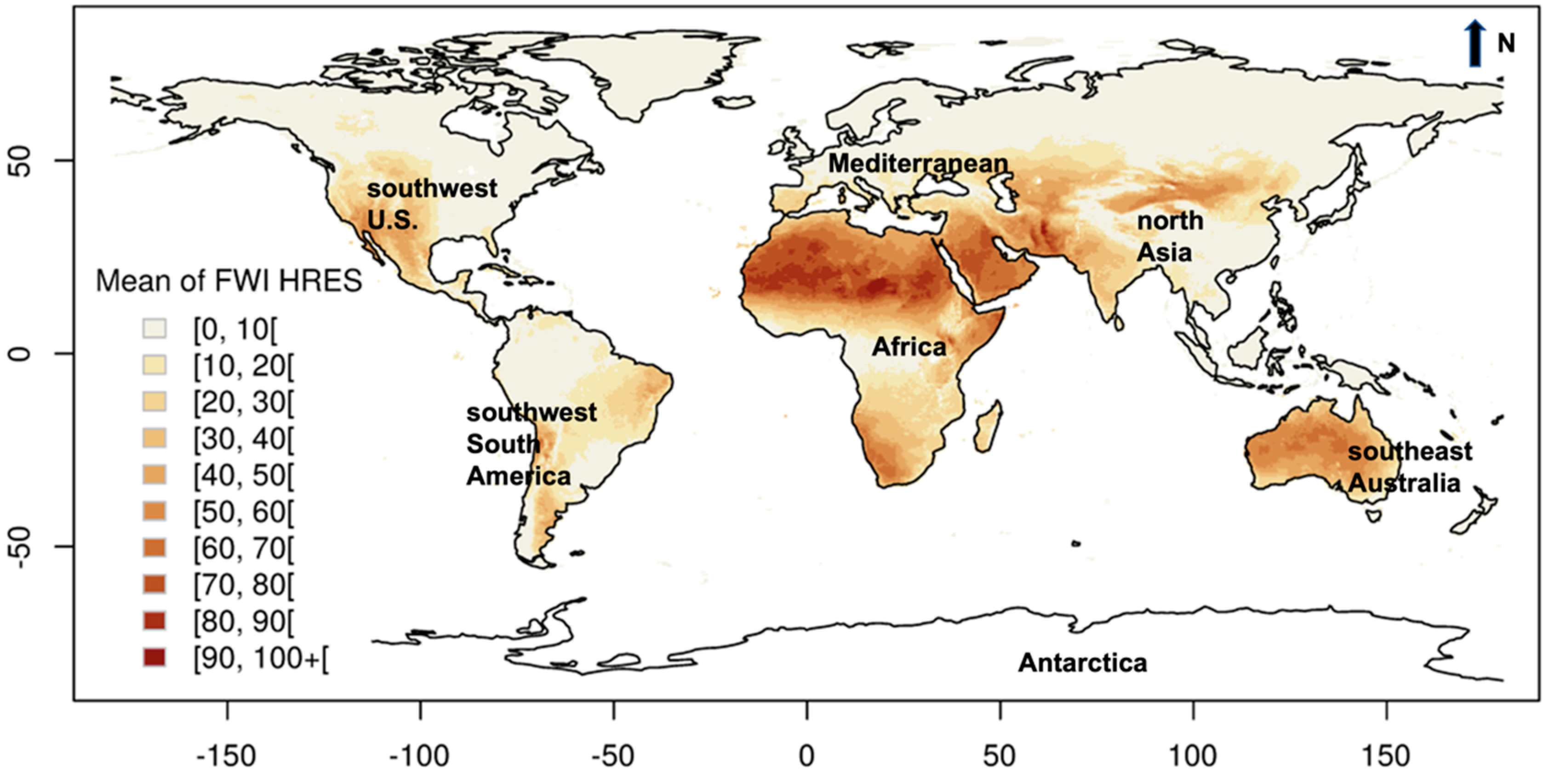
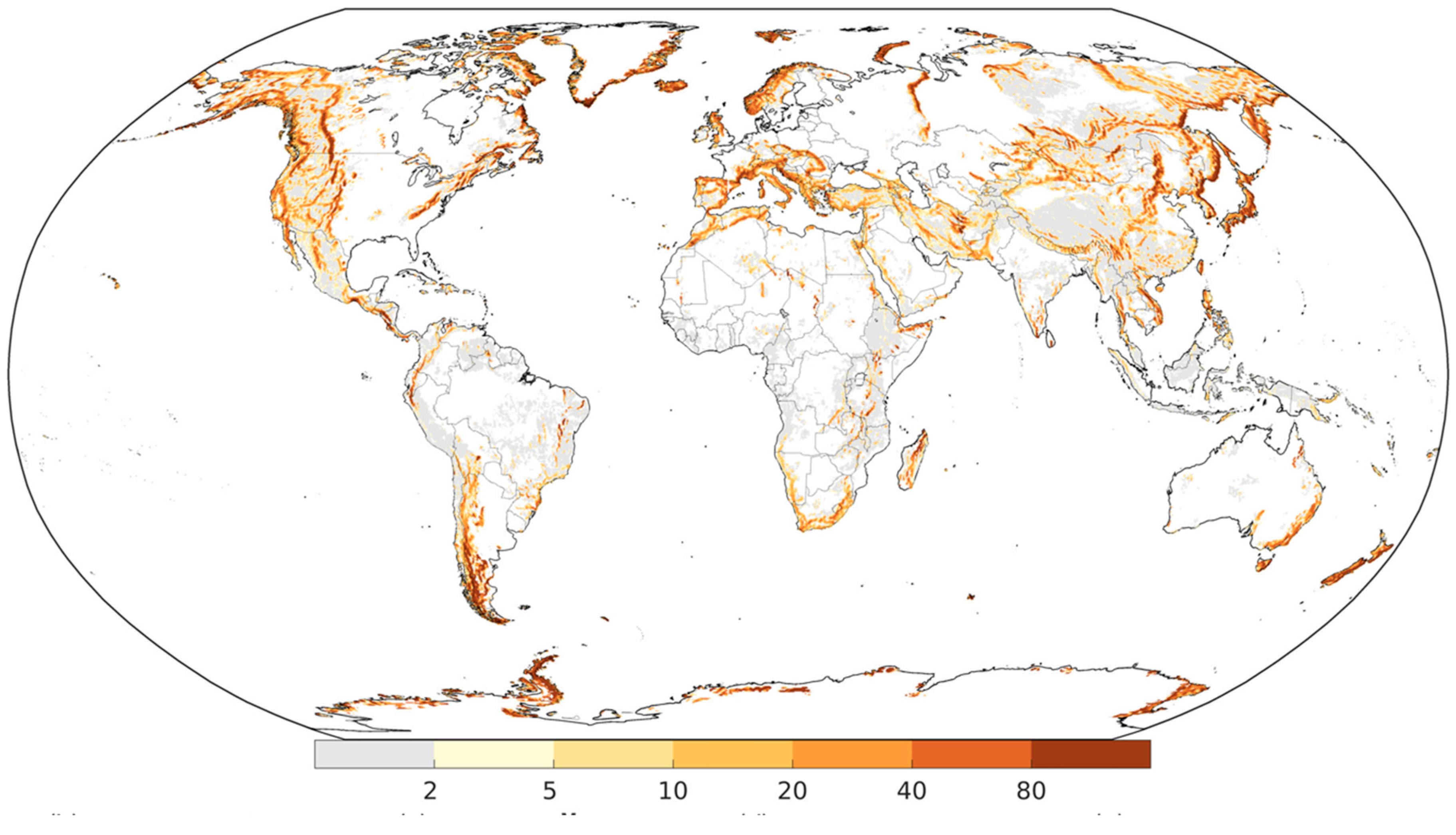
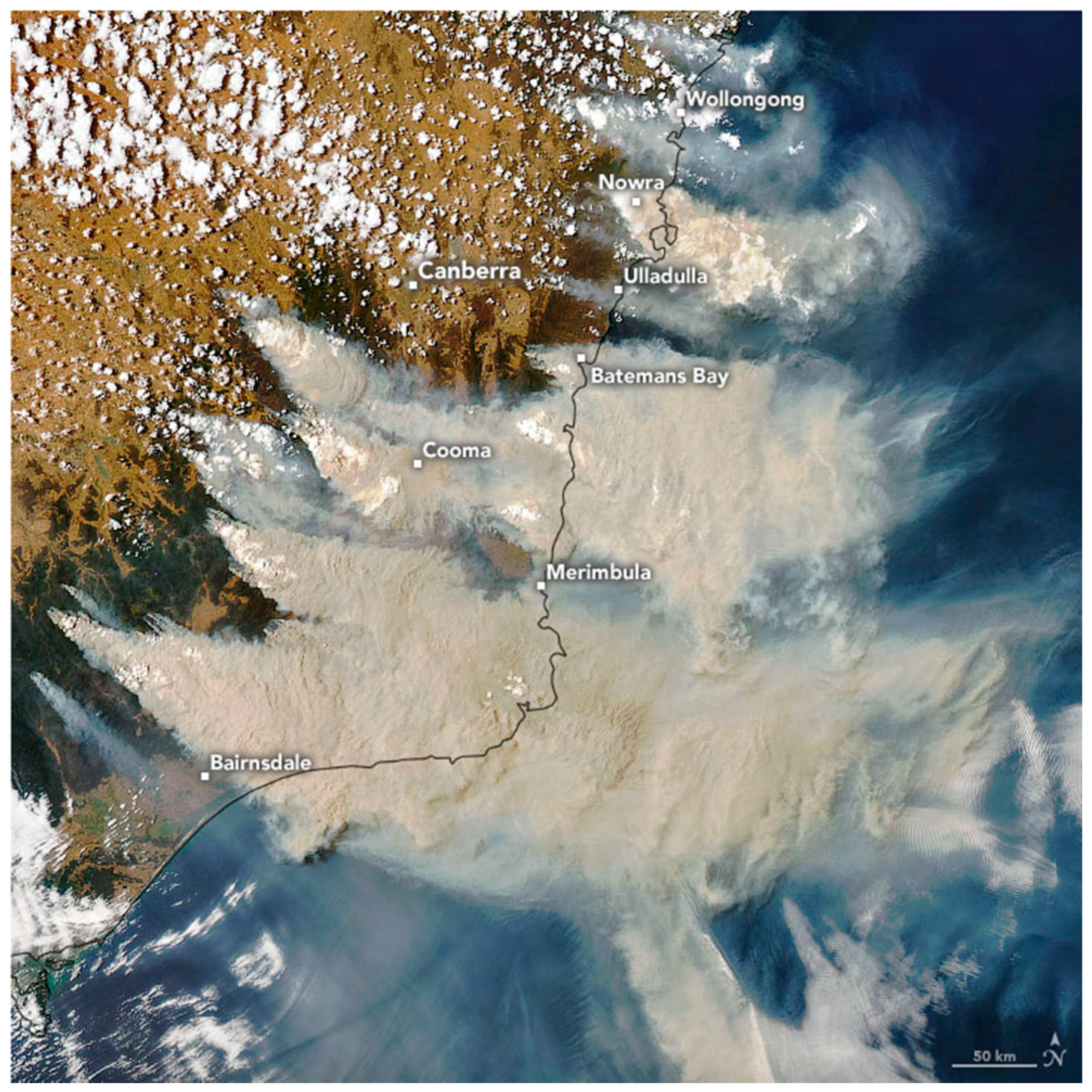
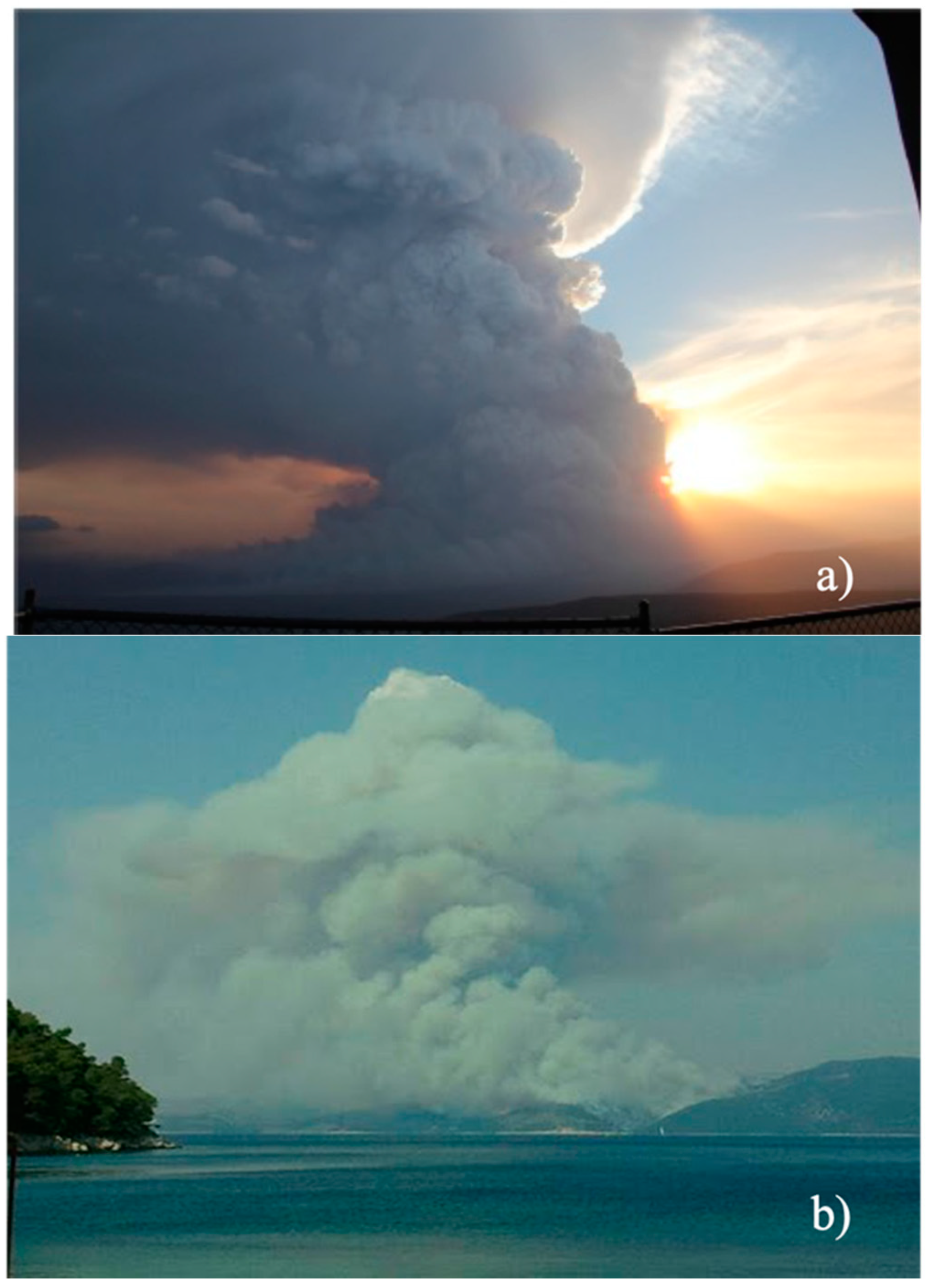
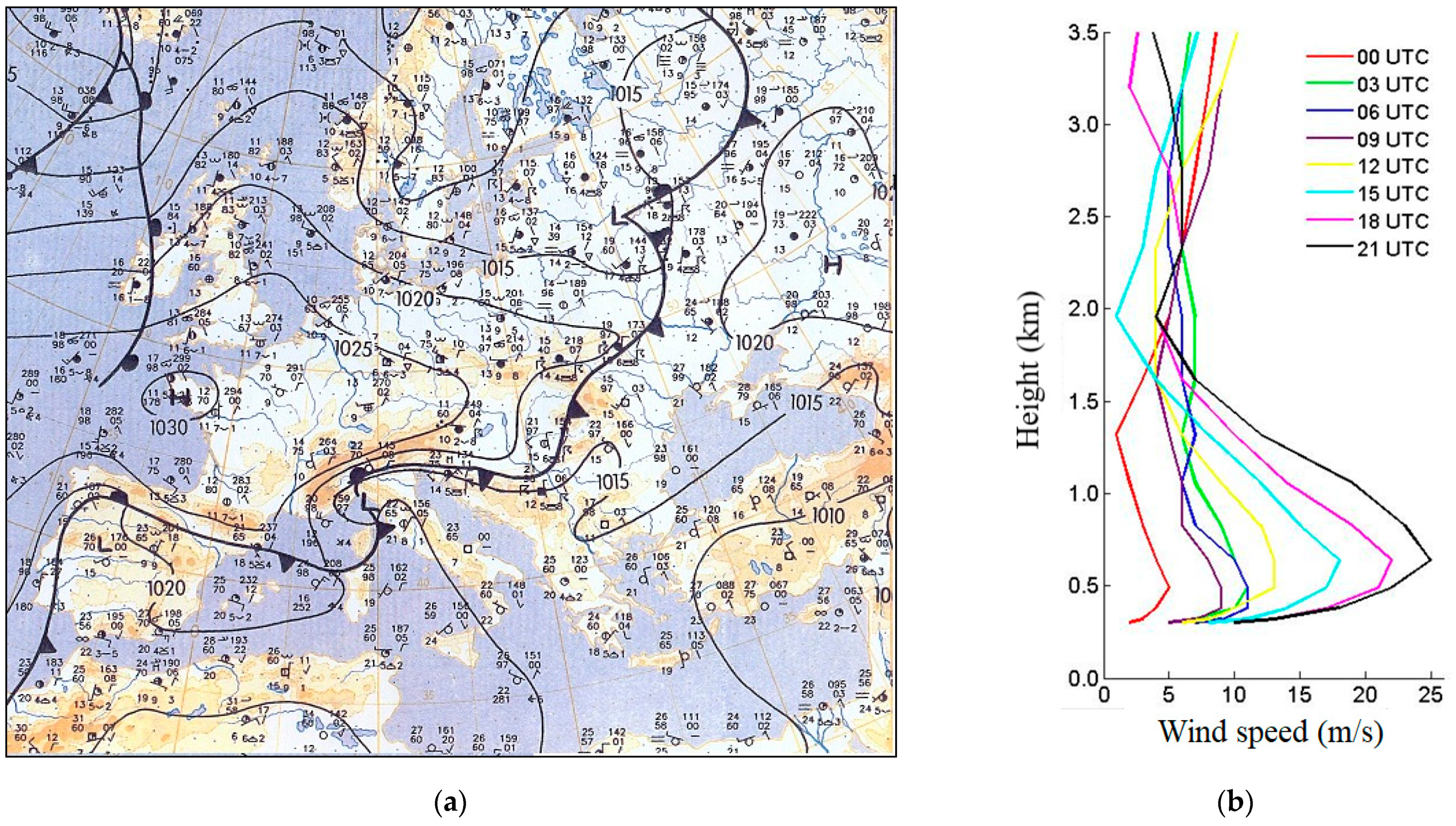
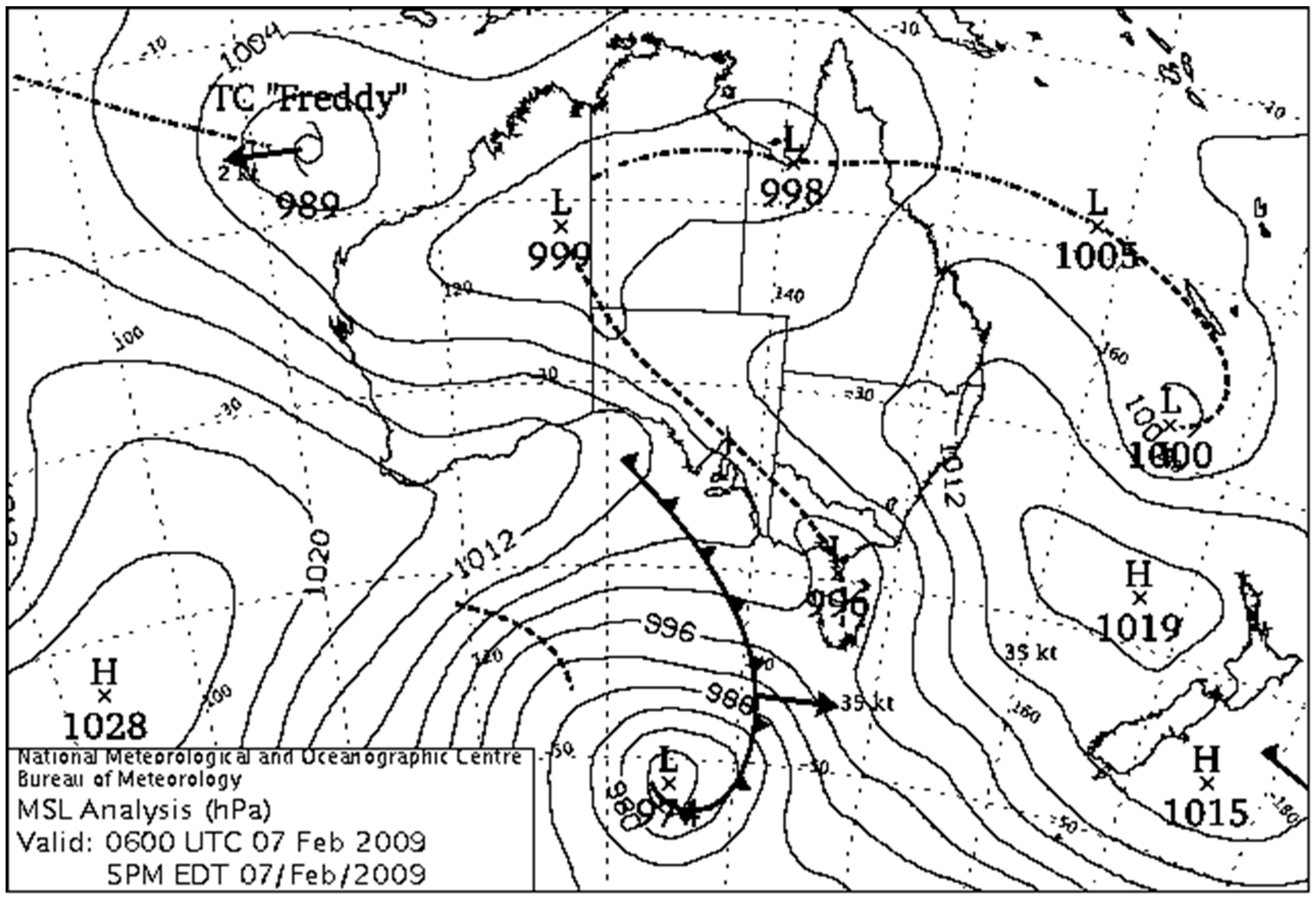
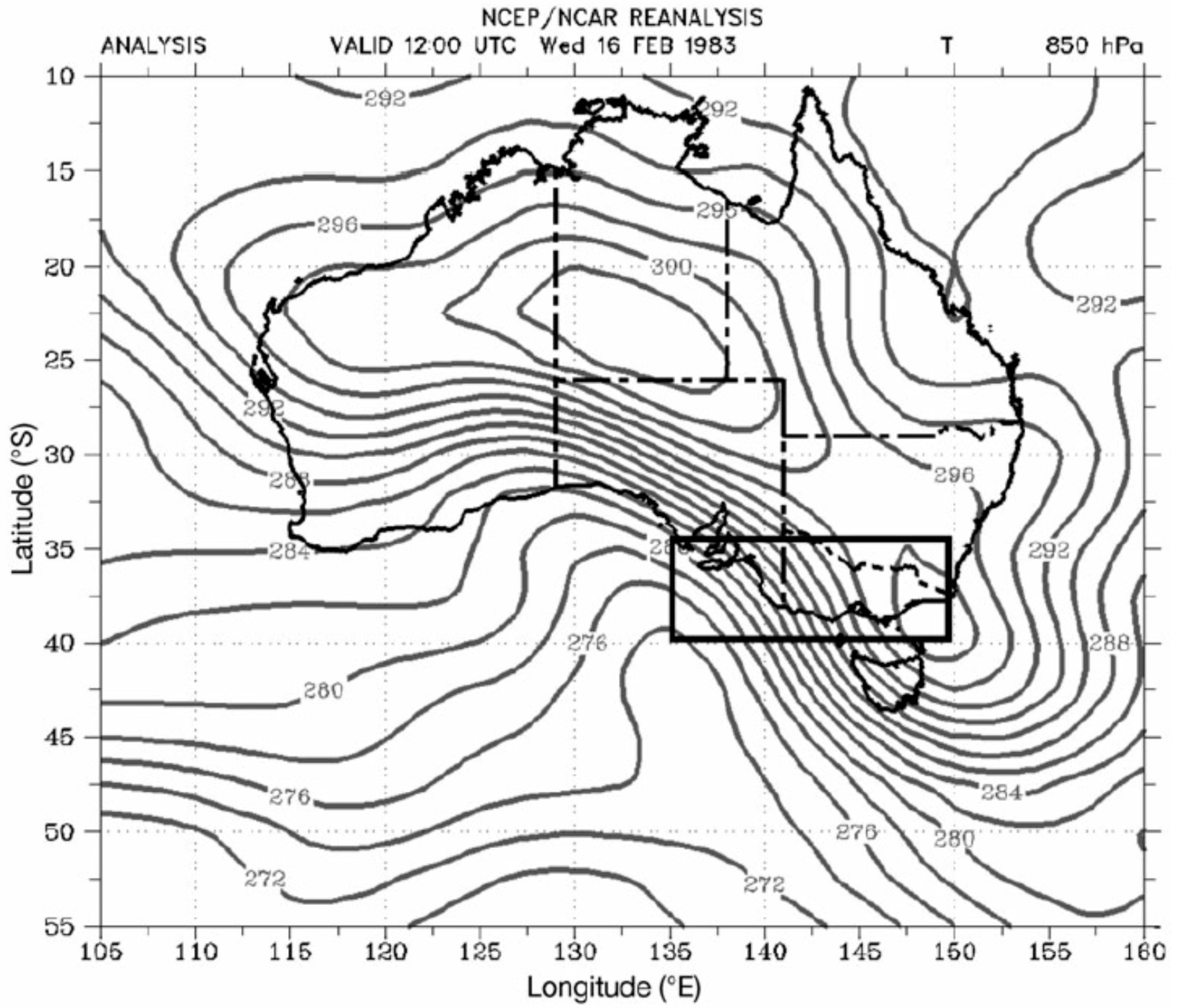
| Adriatic Coast | SE Australia | Impacts | |
|---|---|---|---|
| Synoptic Pattern | Azores anticyclone; Karachi (monsoon) depression; Blocking; Blocking ridge | Tasman Sea Anticyclone driving hot and dry air from the centre of the continent; Strong east–west temperature gradient | Set up of background for hot and dry conditions |
| Strong Winds—Synoptic | Cold front | Cold front, especially summer | Overriding the local coastline circulation; Leading to abrupt change in wind speed and direction |
| Strong Winds—meso- / micro-scale circulation | Orographic wave; hydraulic jump; Low-level jet (LLJ): Examples are jugo (SE), bura (NE) and maestral (NW) winds | Cross-mountain flow; Foehn wind with topographically induced atmospheric wave; Upper-level jet circulation induces dry air to descend | Downslope transport of energy to the lee side; Abrupt warming and drying through adiabatic compression/introduction of upper tropospheric air |
| Atmospheric Stability | Unstable atmosphere favourable for updraft of warm air | Unstable atmospheric favourable for updraft; Plume-dominated wildfire | Favourable for low-level fire inflow, smoke removal and pyroconvection |
| Boundary layer | LLJ leads to strong vertical wind shear and turbulent kinetic energy | Development of deep boundary layer that allows mixing with mid-tropospheric dry air; overnight LLJ development | Favourable for abrupt surface drying and increase in windspeed; overnight progression of elevated fires |
Publisher’s Note: MDPI stays neutral with regard to jurisdictional claims in published maps and institutional affiliations. |
© 2022 by the authors. Licensee MDPI, Basel, Switzerland. This article is an open access article distributed under the terms and conditions of the Creative Commons Attribution (CC BY) license (https://creativecommons.org/licenses/by/4.0/).
Share and Cite
Tomašević, I.Č.; Cheung, K.K.W.; Vučetić, V.; Fox-Hughes, P. Comparison of Wildfire Meteorology and Climate at the Adriatic Coast and Southeast Australia. Atmosphere 2022, 13, 755. https://doi.org/10.3390/atmos13050755
Tomašević IČ, Cheung KKW, Vučetić V, Fox-Hughes P. Comparison of Wildfire Meteorology and Climate at the Adriatic Coast and Southeast Australia. Atmosphere. 2022; 13(5):755. https://doi.org/10.3390/atmos13050755
Chicago/Turabian StyleTomašević, Ivana Čavlina, Kevin K. W. Cheung, Višnjica Vučetić, and Paul Fox-Hughes. 2022. "Comparison of Wildfire Meteorology and Climate at the Adriatic Coast and Southeast Australia" Atmosphere 13, no. 5: 755. https://doi.org/10.3390/atmos13050755






